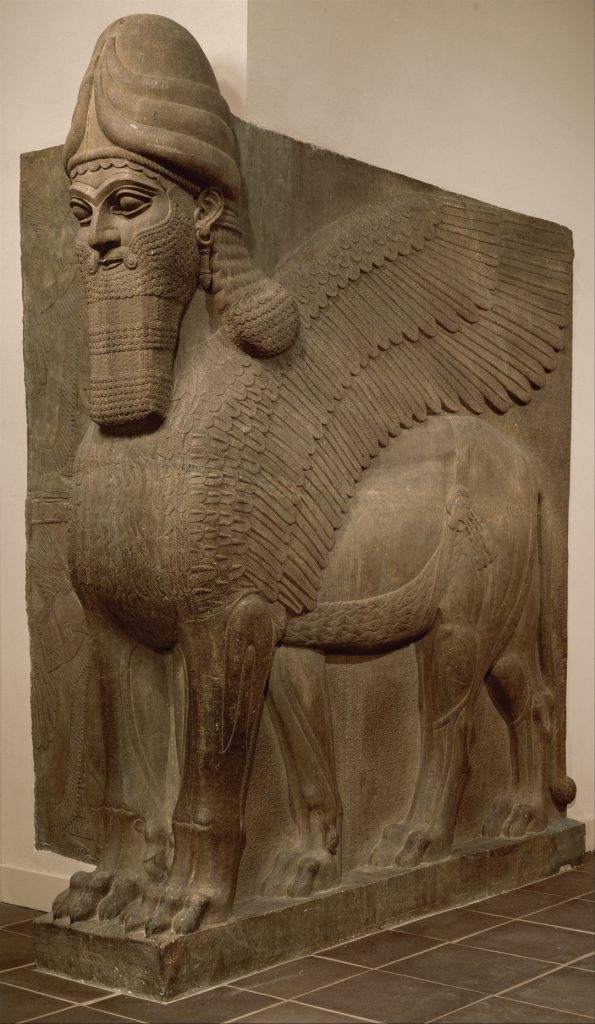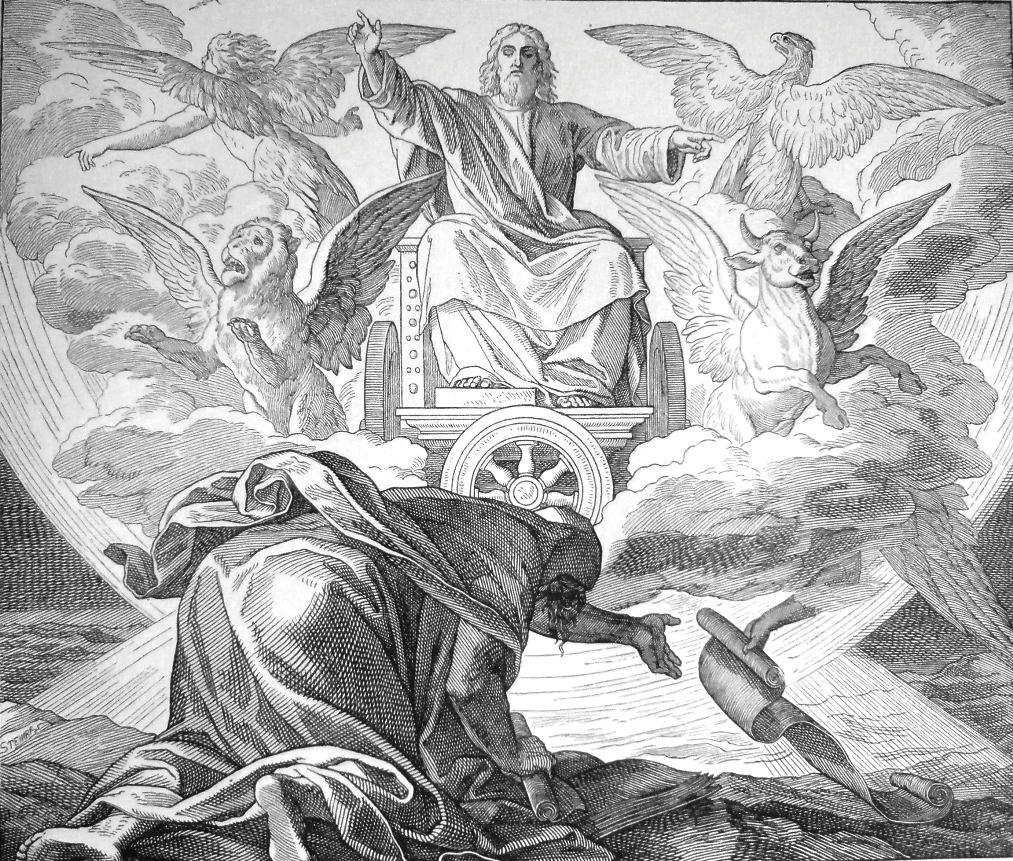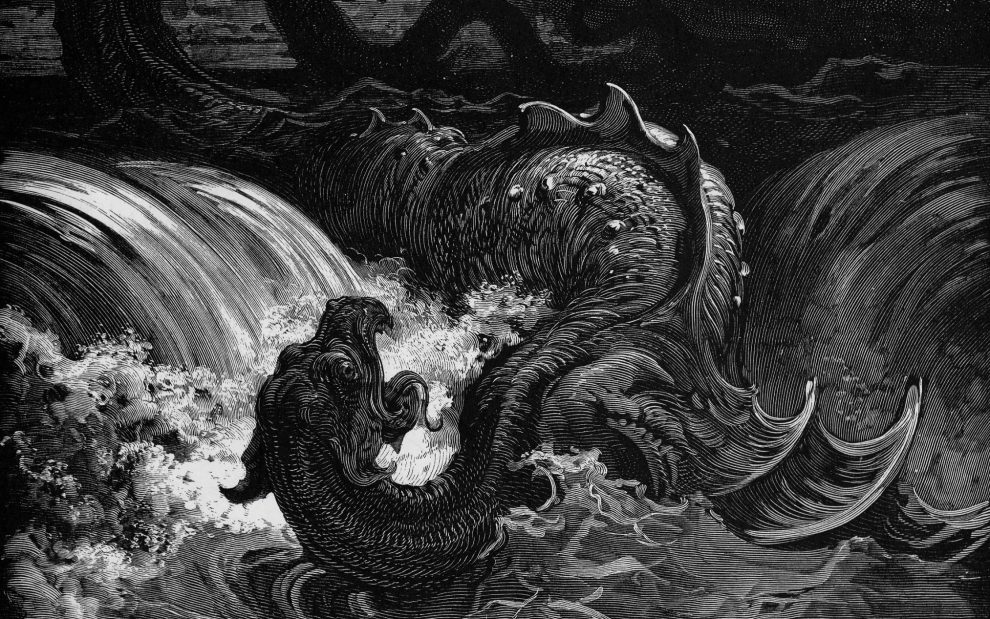Giants, ghosts, and sea monsters. Demons and terrifying hybrid guardians. The Bible is teeming with monsters of all sorts, both those who live on Earth and those who live in the heavens.

The one thing many of these biblical monsters have in common, says Esther Hamori, a professor of the Hebrew Bible at Union Theological Seminary in New York City and author of a new book titled God’s Monsters (Broadleaf Books), is that they are all on God’s team. And this means doing God’s dirty work: The seraphim place burning coals on a man’s lips. The Adversary tortures Job to try to get him to lose his faith. The angels murder thousands throughout scripture in God’s name. And the Leviathan, or sea monster—well, he’s either God’s worst enemy or most-loved creation, depending on which book of the Bible you read.
Over time, many of the most monstrous aspects of these creatures have been sanitized. We went from the biblical cherubim, giant hybrid monsters protecting the Tabernacle, to cherubs, tiny fat winged angels. “I think we want so much for the Bible’s picture of the divine realm to be glorious, safe, and protective,” Hamori says. “But it doesn’t line up with what’s in the Bible itself. When we clean up the monsters, we erase an entire facet of God’s character.”
Hamori, who comes to these texts as both a biblical scholar and a practicing Jew, says that understanding these biblical monsters is more than just a good story. “What if the biblical writers were onto something? I don’t mean the reality of monsters, but what if they had this powerful way of expressing something about the danger and unpredictability of life, and we just clean it up for them?” she asks. “If we sanitize their stories, that’s a loss.”
What is a monster?
Neat definitions of monsters never entirely work. You end up having to include Muppets or exclude zombies or something that should indicate that the definition is faulty. I think of monsters, instead, like a biological family: There’s no single defining trait that all monsters share, but there’s a group of traits that they all draw from in different combinations. No monster has all of the family traits, but all have some.
Biblical monsters all have some of the same traits we see in other ancient mythologies, in medieval texts, and in modern monster shows: giant size, superhuman strength, supernatural powers, hybrid form, changing form (especially when crossing between cosmic realms), absence of form, or amorphous form (like fog).
Can you give an example of a biblical monster?
There are so many fantastic monsters in the Bible. They show up in every part of the biblical universe. In the heavens, for example, are the hybrid seraphim, and the very differently hybrid cherubim. On Earth there are giants. Under the Earth are ghosts and shades, who are different from each other, and sea monsters are out in the deep.
The seraphim and cherubim are some of my favorites, mostly because later Jewish and Christian theology has morphed the biblical depictions of these monsters into something very different. Today they are portrayed as much more peaceful and palatable than they are in the biblical texts.
What’s unsettling is that most biblical monsters, including the most dangerous and deadly, are part of God’s entourage. They’re not monsters that God conquers: They’re monsters who do troubling things on God’s command.
What do biblical monsters say about what the writers of the Bible thought about God?
Ancient perspectives on divine power were different from modern views and values. The great emphasis wasn’t that God was good, but that God was powerful. That might be uncomfortable for us to hear, but that was true for the Mesopotamians, for the Greeks and Romans, and for the writers of the Hebrew Bible and New Testament.
Divine violence wasn’t a theological problem for ancient cultures. For us today, in a world plagued with religiously infused violence of so many kinds, I hope it’s worth reckoning with those questions in a different way.
If it was all about power, why did God need to send monsters to do his work? Why couldn’t he just do it himself?
The biblical God does, occasionally, do his own dirty work, so we know he can. There are texts where he shoots plague at people or burns people up. So why hire out this work?
I doubt it was to protect God’s image. People suggest that it’s meant to hold God at some remove. But I don’t think the writers thought it would work that way. More likely, it’s a common ancient regional expression of divine power: Chief gods often had monstrous underlings at their disposal.

Let’s talk specifically about cherubim. How are they described in the Hebrew Bible?
People today have an image of cherubim as little fat happy angel babies. But that image would be unrecognizable to biblical writers. Cherubim, in the Bible, come in a few different forms, but they are generally massive, winged, animal hybrid guardians standing at gateways of different kinds. They are a regional type of creature that would have been instantly familiar to biblical audiences.
They’re described in a few different ways. For example, in the passage in Kings describing Solomon’s Temple, the cherubim are two giant statues standing one on each side of the Ark of the Covenant facing forward. In many ways, they are similar to pairs of hybrid guardian creatures that often stood at gateways to Neo-Assyrian palaces. If you go to the Metropolitan Museum of Art in New York City, you can see two such statues stationed at a gateway. It’s a pretty intimidating sight.
The cherubim guarding the Holy of Holies in the Temple then come alive in the book of Ezekiel. The prophet Ezekiel envisions them coming to life and becoming one with the throne of God, which becomes a monstrous living chariot. And then, in Revelation in the New Testament, there’s a fantastic conglomeration of images: some next-gen cherubim with seraphim traits all mashed up into one monstrous living creature. And incidentally, in Revelation they also increase in violence.
How did depictions of the cherubim change over time?
There are a lot of biblical texts we can’t date with certainty, but some we can date at least approximately. For example, the text I mentioned in Kings describing Solomon’s Temple was written earlier than texts describing the Tabernacle, even though within the world of the story, the Tabernacle comes first.
If you compare the depictions of the cherubim in the two passages, there’s a stunning development. In Solomon’s Temple, as I said, the cherubim are massive stone statues, one on each side of the Ark, facing forward. They keep people away from the Ark, the Holy of Holies.
But in later descriptions of the Tabernacle, suddenly the pair of cherubim are golden and welded directly onto the top of the Ark. They face each other, and they face down. In other words, they’re no longer just keeping people away. Now, they’re also keeping something inside from getting out. It’s a breathtaking change.
This happens in line with larger developments in texts written during the Babylonian Exile. These later texts, such as the Book of Lamentations, grapple with divine violence. It’s at this time that the cherubim turn to keep something in the Ark.
Ezekiel is also written in exile. Ezekiel’s cherubim come alive and morph into a monstrous living chariot that whisks God out of the Temple as various divine figures rain burning coals down on the city. This terrifying image is also in line with the development of texts at the time. There were terrible events happening that people were either surviving or not surviving. And writers at the time, unsurprisingly, often grappled with what these events suggested about divine violence.
What about a different kind of monster—this time one who lives on Earth. What is the Leviathan?
The Leviathan, along with other unnamed sea monsters, shows up in a lot of biblical texts, including in Isaiah and in several psalms. In these texts, it’s God’s opponent, and he conquers it.
In almost all of these texts, the role of the sea monster is to be conquered by God, to demonstrate God’s power over danger and chaos and other primordial beings. This is remarkably different from the main text in which Leviathan is in the spotlight: Job.
Suddenly, in the Book of Job, God recites a love poem to Leviathan. And I mean that seriously. In both form and content, the Leviathan poem is a recognizable ancient poetic genre: a descriptive love poem.
If it were its own psalm, it would be lovely, in a way. Surprising in juxtaposition with other psalms, perhaps, but lovely. But the love poem in Job isn’t just in the context of any old speech: It’s the culmination of God’s answer to Job in the midst of Job’s suffering, which God and the Adversary caused together.
In one way, God’s whole speech to Job is all about the natural world and centering nature in God’s creation instead of humanity. But looking at the other sea monster texts, where the sea monster is awful and God’s job is to conquer it, it’s a slap in the face for God’s answer to Job’s suffering to be an ode to the Leviathan. God’s response is basically, “My heart belongs to another.” It’s awful. It’s deeply problematic in a way that is completely in line with the rest of the Book of Job.
There was shock value there. A biblical writer was dealing with these difficult, painful reflections on the suffering of Job, and Job was begging God, railing against God, and saying over and over again, “Oh, why won’t you answer me? That you would show up so that I could question you.” And then God’s eventual answer is a love poem to a sea monster.
I don’t think it’s meant to just be God saying, “Really, human beings aren’t at the center of everything,” although that’s a productive reading. I think it’s meant to be shocking and disconcerting—like the rest of the book. It’s meant to be a continuation of this tension we need to hold between Job trying to do right and to be righteous and God’s continued mistreatment of him.
I absolutely understand the instinct to want to make the end of the Book of Job, where God gives him new wealth and a new family, solve the problem of the entire rest of the book. But I don’t think it’s meant to be that sort of book. It presents all sorts of terrible theological problems instigated by God, who flicks a finger over to Job and gets the Adversary to oppose him: “Hey, look at that guy. You think you can corrupt him?” That book is not meant to suddenly, neatly solve its own problem in the last few minutes. It’s a book that remains thoroughly in the tension and that grapples with this divine problem from beginning to end. And to me it’s much more meaningful that way than if a simple easy answer is tacked onto the end.

So why do we tell these stories about biblical monsters? Is it just a good horror story, or is there a deeper importance to these figures?
People have a lot of different views of the Bible. But for anyone who sees the Bible as important for their faith, in all different ways, I think it’s worth exploring this biblical theme, because it mattered to the writers. When I teach this material, my hope isn’t that my students will find a solution or somehow reconcile ancient and modern interpretations of biblical monsters. But I hope they’ll give serious thought to this pervasive pattern of divine violence that runs throughout the Hebrew Bible and New Testament and that they’ll figure out what’s meaningful in it to them.
For both ancient writers and modern readers, monsters speak to our sense that there’s much more out there than meets the eye and that we live in a difficult world. Writing and reading about monsters can be a way to express our fears and to grapple with them.
It also says something about how we envision our relationship with God. For biblical writers in particular, their depictions of monsters show us that their concepts of God were complex, maybe more than we like to think sometimes. They wouldn’t recognize the simple “God is good all the time. All is well” ideas that we hear today. We are the ones who want to keep the monstrous God and the good protective God safely distinct. For people who want to think seriously about the complexity of God in the Bible, this facet of the portrayal of God is something to ponder.
This article also appears in the October 2023 issue of U.S. Catholic (Vol. 88, No. 10, pages 22-26). Click here to subscribe to the magazine.
Header image: Gustave Doré, The Destruction of Leviathan. Wikimedia Commons












Add comment